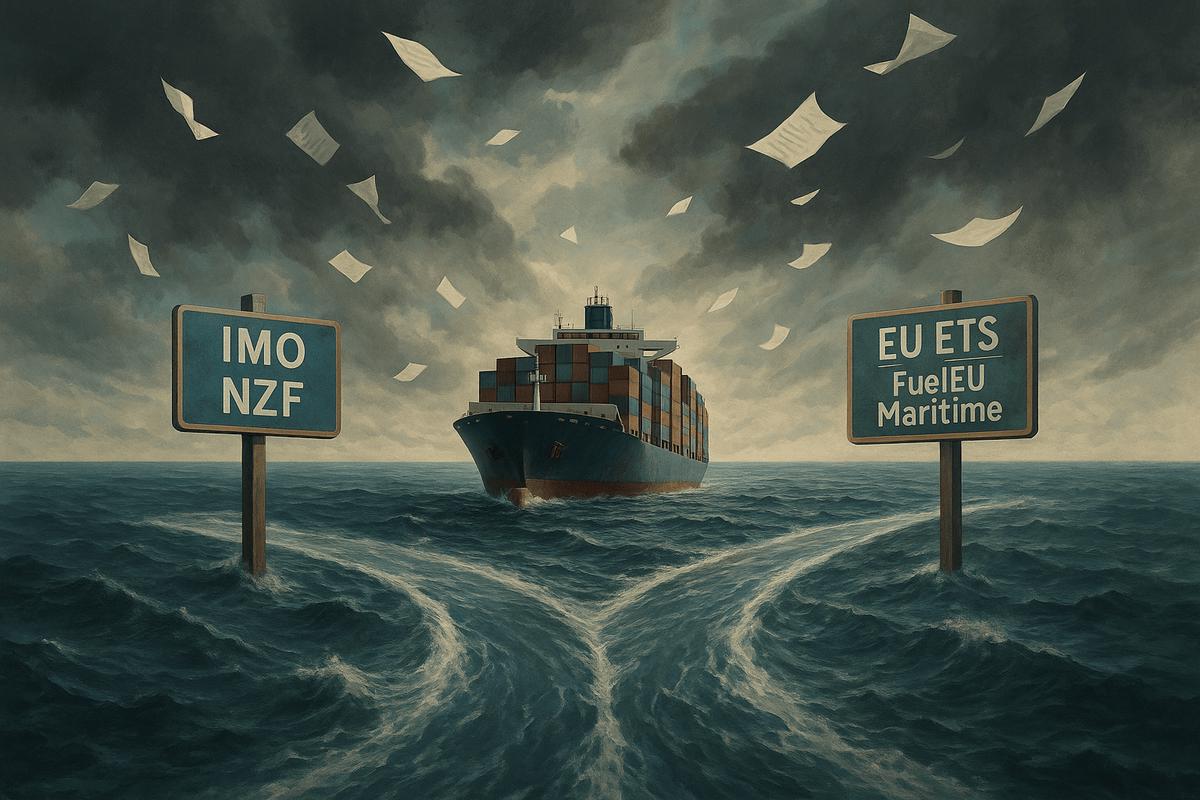The Week in Alt Fuels: Dear regulators, sync the system
Shipowners have a simple ask: align your frameworks, compare your timelines and please talk to each other before overlapping regulations turn ambition into compliance confusion.
 IMAGE: ENGINE via ChatGPT
IMAGE: ENGINE via ChatGPT
The IMO has approved a net-zero framework (NZF), which is expected to be formally adopted in October and implemented by 2027.
If all goes to plan, shipping could soon face two overlapping regimes: the IMO’s global NZF and the EU’s regional FuelEU Maritime (FuelEU) and Emissions Trading System (ETS).
Push for regulatory sync
Lloyd’s Register makes a fair point. There’s a significant lack of alignment between the IMO’s framework and FuelEU Maritime.
FuelEU defines emissions factors, mandates onshore power, incentivises hydrogen-based fuels, includes pooling and sets a clear 2050 target. The IMO's framework lacks all of these.
If NZF enters into force as expected and FuelEU stays in place, ships over 5,000 GT calling at EU ports will face double compliance and twice the paperwork.
Technically, the FuelEU includes "a potential self-destruct mechanism" that allows it to step aside for a global regime.“Recital 69 and Article 30 of the FuelEU regulation state that a global approach by the IMO to limit GHG ship intensity would be preferable and more effective due to its broader scope,” Lloyd’s Register explains.
But the terms under which this clause can be triggered remain vague at best.
The International Chamber of Shipping (ICS) has raised its own set of concerns with the IMO.
The penalties are spelled out clearly enough. But the current framework doesn’t explain how early movers will be rewarded. ICS wants that to change. Replace “may” with “shall,” define how rewards are calculated and offer a tangible upside, it suggests.
The SASHA Coalition echoes the need for alignment but pushes both regulators to raise the ambition.
The EU and the IMO must penalise all shipping emissions and reward only the use of low- and net-zero emission fuels, Aurelia Leeuw, director of EU Policy at SASHA tells ENGINE.
She says the IMO must "set a stringent zero and near-zero fuels definition" based on full lifecycle emissions, including "all climate impacts and indirect land use," and the EU must tighten FuelEU targets.
The ETS only exacerbates the regulatory overlap.
ICS wants the EU to phase out its ETS once the IMO framework is implemented. Running both in parallel could saddle shipowners with overlapping penalties and higher costs.
Environmental group Transport & Environment (T&E) wants EU to keep ETS since it is expected to generate €10 billion/year ($11 billion/year) in Europe, nearly matching the IMO’s global revenue. T&E says a portion of those funds should go toward green fuel production and infrastructure to boost regional fuel independence.
In fact, it wants to go further. “As the IMO NZF exempts so many emissions from carbon pricing, the EU should consider extending the ETS scope to cover 100% of extra-EEA voyages, instead of the current 50%,” it says.
The SASHA Coalition seconds this. The EU must expand “the EU ETS to vessels above 400GT, and reinvesting ETS revenues into driving the lowest emission solutions that the IMO framework fails to adequately boost," Leeuw adds.
Some views differ, others converge. But ultimately all call for clear, transparent rules to close the price gap and drive real alternative fuel uptake.
Without clarity and alignment, shipowners could be pulled down two regulatory paths to the same destination – but each with its own rules, definitions and timelines.
And a possible result? Confusion, complexity, and a slower green fuel transition.
In other news this week, methanol producer The Hong Kong and China Gas Company (Towngas) has supplied 5,000 mt of biomethanol to Singapore-based supplier Golden Island’s bunker vessel, Golden Antares, for a methanol bunkering trial in Singapore.
TotalEnergies and CMA CGM will form a joint venture to supply LNG in Rotterdam using a 20,000-cbm bunker vessel, set to start operations by 2028. It will build on TotalEnergies’ ARA assets, including the Gas Agility bunker vessel, which will be later merged into the new venture.
The European Commission is now preparing “a range of actions” to strengthen the biofuel certification system following its investigation into alleged fraud in biofuel imports from China. Legal text is expected by early 2026, with input from stakeholders.
Italy’s Grimaldi Group has launched the first of ten ammonia-ready pure car and truck carriers (PCTCs) being built by China Merchants Heavy Industries. Ammonia-ready means the vessel can be converted to run on ammonia fuel in the future through retrofitting but cannot use ammonia immediately upon delivery.
By Konica Bhatt
Please get in touch with comments or additional info to news@engine.online





